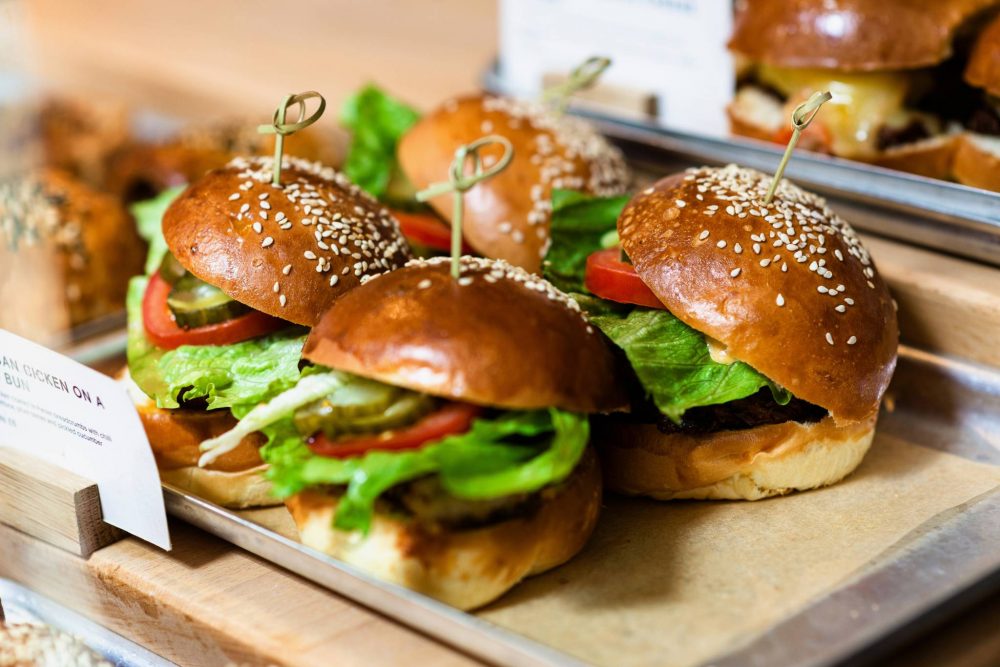When it comes to crafting a great sandwich, details matter—and that’s where Eaten Alive’s expertise in pickling and fermentation comes into play. By taking fresh vegetables and simply adding salt, co-founders Pat and Glyn set in motion a process of natural alchemy that transforms humble ingredients into extraordinary ferments, preserving them without overwhelming their inherent taste.
What emerges from this simple yet transformative process are ferments that are layered, deeply flavourful and good for you too, thanks to the probiotics created in the process.
Cabbage becomes robust, punchy kimchi. Carrots, chillies and cucumbers evolve into pickles and hot sauces that are alive with complexity and flavour.
Eaten Alive’s ferments can be used to bring depth and nuance to all sorts of dishes, and we’re proud to use them in our Pastrami Bagel, Smoked Salmon Bagel, Mortadella & Ricotta Sandwich and Parmesan Chicken Bun.
The perfect sandwich needs the perfect pickle
A sandwich is only as good as the quality of bread used. But it’s also about the nuanced layers of flavour created by your fillings, achieved by using top quality products like Eaten Alive’s ferments. The crunch, the tang and the savoury goodness all contribute to taking your sandwich from good to great.
Guided by their passion for food, co-founders Pat and Glyn, each with over 20 years of experience in the culinary world, are on a mission to bring fermented foods from obscurity to everyone’s plates. Below, Pat opens the lid on how to create the perfect sandwich condiments—from the ideal vegetables for home pickling to how long the fermentation process should take.
Behind the brine: Fermentation Q&A
- What do you think makes the perfect ferment or pickle?
It’s about balance I feel, the acidity should be balanced with the salt and crunch (and sweet for vinegar pickles). For ferments you also want that mysterious and satisfying umami.
- What food does kimchi make the perfect accompaniment for?
Kimchi is an absolute wonder ‘pickle’ – it is tart, salty and spicy, so it seasons foods like rice or avocado, but also its punchy flavour is a great foil for stronger tasting foods like cheeses and red meats.
- What is your sandwich filling of choice with ferments and pickles?
We love a kimchi cheese toastie at Eaten Alive.
- What can I put in my pickle if I’m making one at home?
It’s a great idea to use up extra vegetables – alway use firm fresh ones. Root and hard vegetables like cabbages will pickle well as they will maintain their bite, but softer veg is great too, and adding some fresh herbs to vinegar pickles is great.
- How long does the fermentation process take?
It can take anywhere from a few days for fresh cucumber kimchi to 12 months for miso pickles.
- What are the health benefits of fermented foods?
First there are the obvious benefits of more vegetables, but also by using these kinds of pickles as condiments you will cut out a bit of sugar as well. Most importantly, as long as they are raw and unpasteurised, then you will be consuming lots of friendly bacteria that help support your microbiome. Our microbiome is vital for many of our most basic functions but also affects mood, skin, energy and immunity.
- Do you have any top tips for creating your own ferments and pickles at home?
Just be creative. Basing the brines on your favourite dishes can be a good start – but avoid trying to ferment leafy greens and herbs. Also using the dishwasher on its hottest cycle is a great way of disinfecting any kit as everything needs to be spotless to ferment reliably.
- What do I need to make my own ferments and pickles at home?
Just a jar and some salt really, and then your ingredients. There are heaps of home fermentation kits you can get if you want to get serious.
Pop into your local bakery, or order online, to discover the flavours and gut-supportive benefits of Eaten Alive’s ferments in our select sandwiches.

